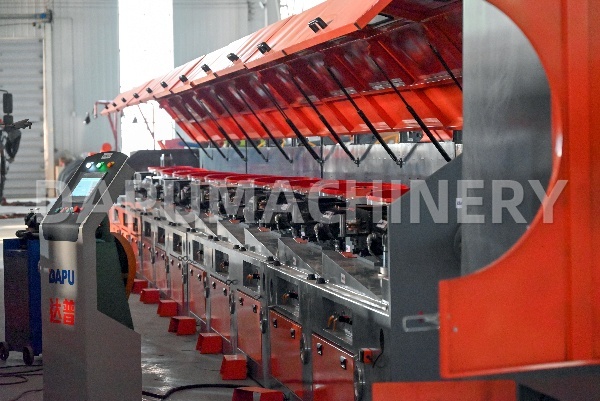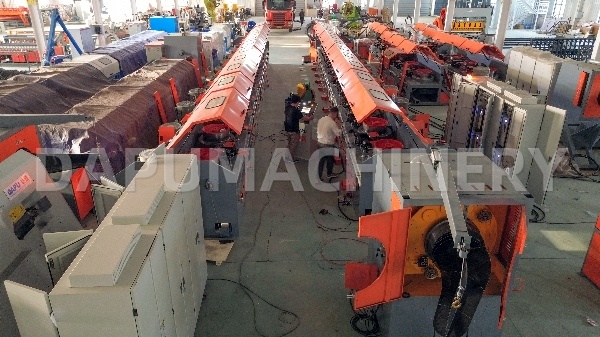
How to Choose the Right Straight Wire Drawing Machine for Low & High Carbon Steel
Category:News
Author:
Source:
Add time:2025-04-30 11:28
Selecting the right straight wire drawing machine is critical for manufacturers working with low-carbon and high-carbon steel wires. These materials serve vastly different purposes—low-carbon steel is ideal for fencing, nails, and basic construction, while high-carbon steel is used in automotive springs, reinforced cables, and industrial machinery. For markets like South America, Africa, Southeast Asia, and the Middle East, where industries range from small-scale workshops to large infrastructure projects, choosing equipment that balances cost, efficiency, and durability is essential. This guide breaks down the key factors to consider, with a focus on DAPU’s LZ-560C and LZ-600C models, to help you make an informed decision.


1. Understand Material Requirements
Low-Carbon Steel (Mild Steel)
Properties: Soft, ductile, easy to shape.
Applications: Barbed wire, mesh, nails, handicrafts.
Machine Needs:
Lower tension requirements.
Faster drawing speeds for mass production.
Cost-effective energy usage.
High-Carbon Steel
Properties: Hard, strong, resistant to wear.
Applications: Springs, cables, tools, reinforcement bars.
Machine Needs:
Higher motor power to handle rigidity.
Precision dies to prevent surface cracks.
Adjustable speed controls for varying thicknesses.
Why It Matters:
In regions like Nigeria (construction) or Vietnam (automotive parts), using the wrong machine for the material can lead to wire breakage, poor surface finish, or excessive energy costs.
2. Key Machine Specifications to Compare
A. Inlet and Outlet Diameter
Low-carbon steel: Typically requires thinning from ≤6.5mm to ≥1.6mm (e.g., DAPU LZ-560C).
High-carbon steel: Often starts thicker (≤8mm) and is drawn to ≥4mm (e.g., DAPU LZ-600C).
Regional Insight:
In Africa, where recycled steel is common, machines must handle irregular wire thicknesses. DAPU’s adjustable dies ensure consistent output even with variable inputs.
B. Motor Power
Low-carbon: 22KW motors (LZ-560C) suffice for softer wires, reducing energy costs in areas like rural Indonesia with unstable grids.
High-carbon: 30KW–37KW motors (LZ-600C) provide the torque needed for rigid steel, critical for Saudi Arabian oil rig cables or South African mining equipment.
C. Drawing Speed
Low-carbon: Prioritize speed (up to 16m/s for LZ-560C) to meet high-volume demand for fencing or roofing wires.
High-carbon: Opt for adjustable speeds (LZ-600C) to balance precision and productivity when drawing thicker, harder wires.
D. Reel Capacity
Larger reels (560mm–600mm) minimize downtime for reloading—crucial for 24/7 operations in Middle Eastern factories.
3. Match the Machine to Your Production Scale
Small Workshops (Africa, Southeast Asia)
Scenario: A Kenyan workshop producing barbed wire from recycled low-carbon steel.
Ideal Choice: DAPU LZ-560C.
Low power consumption (22KW) suits limited grid capacity.
Compact design fits tight spaces.
Easy maintenance with modular parts.
Mid-Sized Factories (South America, Middle East)
Scenario: A Brazilian plant manufacturing springs for the automotive sector.
Ideal Choice: DAPU LZ-600C.
Handles high-carbon steel (≤8mm) with a 37KW motor.
Adjustable speed ensures precision for specialty wires.
Large-Scale Operations (Infrastructure Hubs)
Scenario: A UAE supplier producing steel cables for construction projects.
Solution: Combine multiple LZ-600C units for high throughput and redundancy.
4. Evaluate Environmental Adaptability
Emerging markets often face harsh operating conditions:
Humidity (Southeast Asia, Coastal Africa):
Choose machines with anti-corrosion coatings (e.g., DAPU’s galvanized components).
Dust (Middle Eastern deserts):
Opt for sealed bearing systems to prevent abrasive damage.
Power Fluctuations (Rural South America, Africa):
Machines with lower KW ratings (e.g., 22KW LZ-560C) reduce blackout risks.
5. Total Cost of Ownership (TCO)
Beyond the initial price, consider:
Energy Efficiency:
DAPU’s LZ-560C consumes 30% less power than competitors’ 25KW models.
Maintenance Costs:
Standardized die sizes (used in DAPU machines) cut replacement part expenses.
Downtime Losses:
Large 600mm reels on the LZ-600C reduce reloading frequency by 40%.
6. DAPU LZ Series: A Side-by-Side Comparison
| Feature | LZ-560C | LZ-600C |
|---|---|---|
| Target Material | Low-carbon steel | Medium/high-carbon steel |
| Inlet Diameter | ≤6.5mm | ≤8mm |
| Outlet Diameter | ≥1.6mm | ≥4mm |
| Motor Power | 22KW | 30KW / 37KW |
| Max Speed | 16m/s | Adjustable (based on wire type) |
| Reel Diameter | 560mm | 600mm |
| Best For | Small workshops, humid climates | Heavy-duty production, harsh environments |
7. Pitfalls to Avoid
Overpowered Machines: A 45KW machine in a Nigerian village may strain local grids.
Ignoring Die Quality: Cheap dies wear out quickly with high-carbon steel, increasing long-term costs.
One-Size-Fits-All: A factory producing both low and high-carbon wires should invest in separate machines (e.g., LZ-560C + LZ-600C).
8. Future-Proofing Your Investment
Upgradability: The LZ-600C allows die modifications for future high-carbon projects.
Local Support: DAPU’s service centers in Kenya, UAE, and Vietnam ensure quick repairs.
Conclusion
Choosing the right straight wire drawing machine for low and high-carbon steel hinges on aligning material properties, production scale, and local operating conditions. For small-scale, low-carbon projects in power-scarce regions, the DAPU LZ-560C offers unmatched efficiency. For heavy-duty high-carbon wire production, the LZ-600C delivers the power and precision needed in harsh environments. By prioritizing energy savings, durability, and ease of maintenance—key concerns in Africa, Southeast Asia, and beyond—businesses can maximize productivity and ROI.
Whether you’re drawing wires for Indonesia’s palm oil捆扎 or Qatar’s World Cup stadiums, the right machine ensures your steel meets global standards while adapting to local challenges.
Recommend News




